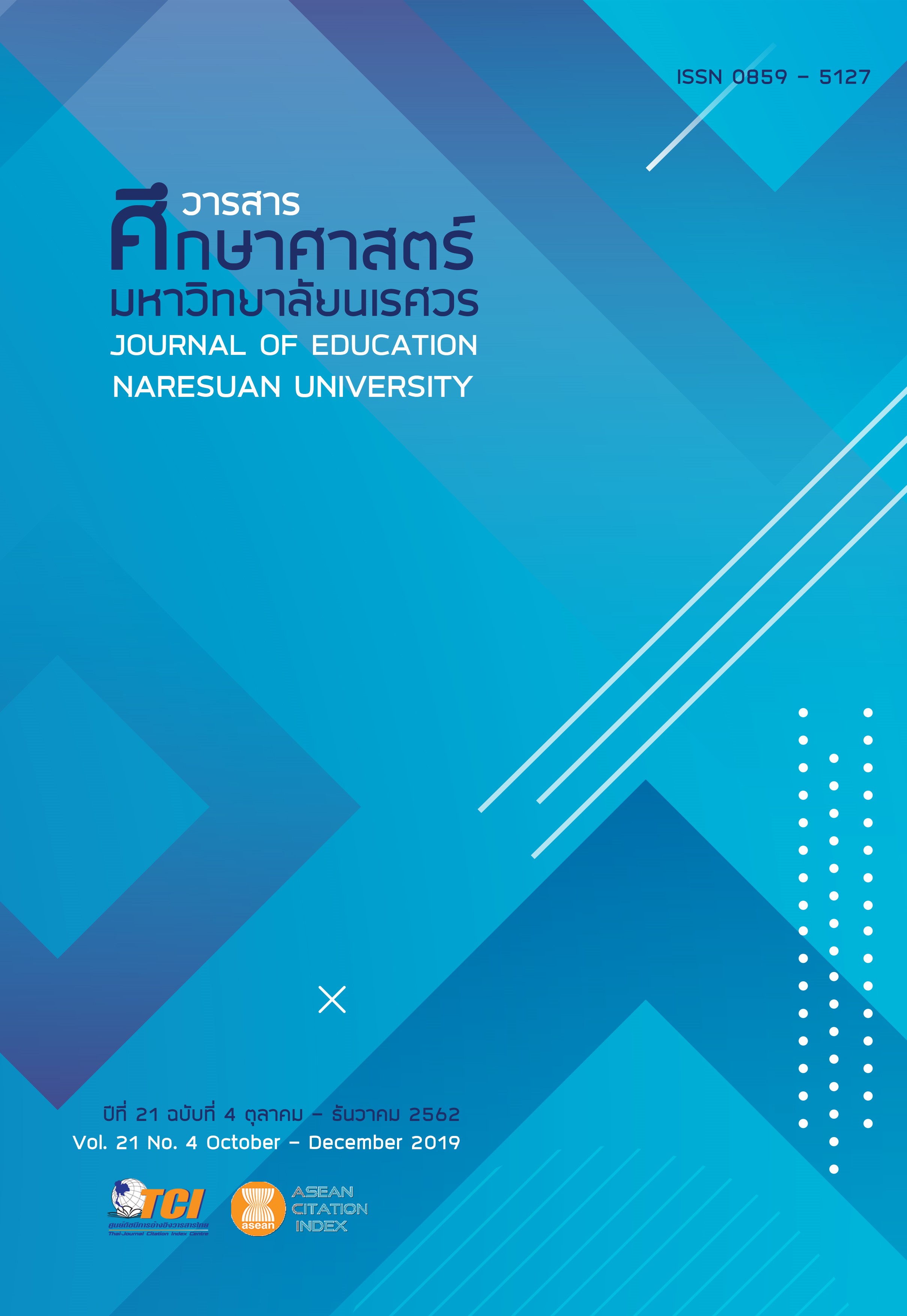การพัฒนารูปแบบการประเมินความสามารถในการประเมินได้ของโครงการทางการศึกษา (A DEVELOPMENT OF THE EVALUABILITY ASSESSMENT MODEL FOR EDUCATIONAL PROGRAM)
Main Article Content
Abstract
การวิจัยนี้มีวัตถุประสงค์เพื่อพัฒนารูปแบบการประเมินความสามารถในการประเมินได้ (Evaluability Assessment: EA) ของโครงการทางการศึกษา ดำเนินการวิจัยโดยใช้กระบวนการวิจัยและพัฒนา ประชากร คือ โครงการทางการศึกษา โรงเรียนสังกัดสำนักงานเขตพื้นที่การศึกษามัธยมศึกษา เขต 17 กลุ่มตัวอย่างที่ทดลองใช้รูปแบบการประเมิน คือ โครงการทางการศึกษา โรงเรียนสอยดาววิทยา จันทบุรี โดยการเลือกแบบเจาะจง เครื่องมือที่ใช้ในการวิจัย ประกอบด้วย แบบสัมภาษณ์กึ่งโครงสร้าง ตัวแบบโมเดลเชิงตรรกะ คู่มือการประเมินความสามารถในการประเมินได้ และแบบประเมินรูปแบบการประเมินความสามารถในการประเมินได้ วิเคราะห์ข้อมูลโดยใช้สถิติพื้นฐาน คือ ค่าเฉลี่ย ( ) ค่าเบี่ยงเบนมาตรฐาน (S.D.) และทำการวิเคราะห์เนื้อหาสำหรับข้อมูลเชิงคุณภาพ ผลการวิจัย พบว่า รูปแบบการประเมินความสามารถในการประเมินได้ของโครงการทางการศึกษา มีกระบวนการดำเนินงาน 6 ขั้นตอน ดังนี้ ขั้นตอนที่ 1 สร้างความสัมพันธ์กับผู้ใช้ผลการประเมินที่เป็นเป้าหมาย ขั้นตอนที่ 2 ทำความเข้าใจเจตนาของโครงการให้ชัดเจน ขั้นตอนที่ 3 ค้นหาความจริงในโครงการ ขั้นตอนที่ 4 ตกลงกันให้ได้ว่าจะเปลี่ยนแปลงการออกแบบโครงการอะไรบ้าง ขั้นตอนที่ 5 ค้นหาการออกแบบการประเมินผลที่เป็นทางเลือก และขั้นตอนที่ 6 ตกลงกำหนดลำดับความสำคัญของการประเมินผลและการใช้ประโยชน์จากข้อมูลที่ได้จากการประเมินผลการประเมินรูปแบบการประเมินความสามารถในการประเมินได้ของโครงการทางการศึกษา พบว่า มีคุณภาพตามเกณฑ์มาตรฐานการประเมินโครงการของคณะกรรมการร่วมพัฒนาคุณภาพงานประเมินทางการศึกษา ทั้ง 4 มาตรฐาน ดังนี้ มาตรฐานด้านการใช้ประโยชน์ มีคุณภาพอยู่ในระดับมาก (
= 4.14, S.D. = 0.70) มาตรฐานด้านความเป็นไปได้ มีคุณภาพอยู่ในระดับมาก (
= 4.07, S.D. = 0.70) มาตรฐานด้านความเหมาะสม มีคุณภาพอยู่ในระดับมาก (
= 4.24, S.D. = 0.68) และมาตรฐานด้านความถูกต้องแม่นยำ มีคุณภาพอยู่ในระดับมาก (
= 4.24, S.D. = 0.75) เมื่อพิจารณาในภาพรวม พบว่า รูปแบบการประเมินความสามารถในการประเมินได้ของโครงการทางการศึกษา มีคุณภาพตามเกณฑ์มาตรฐานการประเมินอยู่ในระดับมาก (
= 4.20, S.D. = 0.72)
A DEVELOPMENT OF THE EVALUABILITY ASSESSMENT MODEL FOR EDUCATIONAL PROGRAM
The purpose of this study was to develop the Evaluability Assessment Model for education program and used Research and development in this. The population were programs on basic school under the Office of the Secondary Educational Service Area 17. The model implementation was used with education programs at Soi-Dao Wittaya School, Chantaburi. The instruments used in the research were: a semi-structured interview, logic model template, a manual of the development of the evaluability assessment model for educational program, and an evaluation model assessment form. Data was analyzed by using basic statistics (Mean, SD) and content analysis for qualitative data. The result of the research were found as follows: A development of the evaluability assessment model for educational program had 6 steps: 1) Innovative intended users, 2) Clarify program intent, 3) Explore program reality, 4) Reach agreement on any needed changes in the program design, 5) Explore alternative evaluation designs, and 6) Agree on evaluation priorities and intended uses of evaluation information. The development of the evaluability assessment model for educational program based on the assessment criteria were utility, feasibility, propriety and accuracy at the high level ( = 4.20, S.D. = 0.72). When classified according to the evaluation standard, utility standards are high level (
= 4.14, S.D. = 0.70), feasibility standards are high level (
= 4.07, S.D. = 0.70), propriety standards are high level (
= 4.24, S.D. = 0.68), and accuracy standards are high level (
= 4.24, S.D. = 0.75).
Article Details
The owner of the article does not copy or violate any of its copyright. If any copyright infringement occurs or prosecution, in any case, the Editorial Board is not involved in all the rights to the owner of the article to be performed.
References
2. Joseph S. Wholey, Harry P. Hatry, & Kathryn E. (2010). Handbook of practical program evaluation (3rd ed.). San Francisco, CA: John Wiley & Sons.
3. Joyce, B., Weil, M. & Calhoun, E. (2004). Model of teaching (7th ed.). Boston: Allyn and Bacon.
4. Kanchanawasri, S. (2004). Evaluation theory (4th ed.). Bangkok: Chulalongkorn University Press. [in Thai]
5. Ketsuwan, R. (2012). Evaluation of public policy. Bangkok: Bopit Printing. [in Thai]
6. Kooariyakul, A. (2010). A development of the performance evaluation model for the nursing students of Praboromarajchanok Institute (Doctoral dissertation). Phitsanulok: Naresuan University. [in Thai]
7. Leviton, L. C., & Gutman, M. A. (2010). Overview and rationale for the systematic screening and assessment method. In L. C. Leviton, L. Kettel Khan, & N. Dawkins (Eds.), The Systematic Screening and Assessment Method: Finding innovations worth evaluating. New Directions for Evaluation, 125, 7–31.
8. Ritcharoon, P. (2014). Project evaluation techniques. Bangkok: House of Kermyst. [in Thai]
9. Samakkhi, P. (2009). Developing a plan/project evaluation model at secondary schools (Doctoral dissertation). Maha Sarakham: Mahasarakham University. [in Thai]


